
William Herschel discovered NGC 3930 = H III-616 = h1000 on 17 Mar 1787 (sweep 714) and recorded "vF, cS, just south of a star 6th mag. I suspected at first that my glass had been affect with damp." On 23 Mar 1789 (sweep 915) he logged "eF, irr figure, 3 or 4' dia, resolvable. About 5' south of a star 6th mag." In his 1814 PT paper, WH mentions that on one observation he logged "A star of the 6th magnitude, about 5' north of a very faint nebula, or an irregular figure." But on a observation two years before, the two objects were then so near each other, as, at first sight, it caused a suspicion that some damp had settled upon the eye-glass and affected the star. He commented this might suggest that the nebula had a considerable proper motion, though differences in observing conditions might account for the difference. Coincidentally, this star is Groombridge 1830, which has the third fastest known proper motion of 7.04"/yr and this star is now roughly 23' SE! But in a two-year period there was not a significant proper motion of the star.
400/500mm - 18" (4/5/03): very faint, moderately large, round. Appears as a very diffuse ill-defined glow with just a weak concentration. It was not initially noticed initially in the field. Located 2.5' E of a mag 13 star, the southernmost of three collinear mag 13/13.5 stars. John Herschel mentioned a 7th magnitude star which followed due east by 3'. This is Groombridge 1830, which has the third fastest known proper motion (7.04"/yr) and this star is now roughly 23' SE!
Notes by Steve Gottlieb